
Gobiidae or gobies is a family of bony fish in the order Gobiiformes, one of the largest fish families comprising more than 2,000 species in more than 200 genera. Most of gobiid fish are relatively small, typically less than 10 cm (3.9 in) in length, and the family includes some of the smallest vertebrates in the world, such as Trimmatom nanus and Pandaka pygmaea, Trimmatom nanus are under 1 cm long when fully grown, then Pandaka pygmaea standard length are 9 mm (0.35 in), maximum known standard length are 11 mm (0.43 in). Some large gobies can reach over 30 cm (0.98 ft) in length, but that is exceptional. Generally, they are benthic or bottom-dwellers. Although few are important as food fish for humans, they are of great significance as prey species for other commercially important fish such as cod, haddock, sea bass and flatfish. Several gobiids are also of interest as aquarium fish, such as the dartfish of the genus Ptereleotris. Phylogenetic relationships of gobiids have been studied using molecular data.

Eleotridae is a family of fish commonly known as sleeper gobies, with about 34 genera and 180 species. Most species are found in the tropical Indo-Pacific region, but there are also species in subtropical and temperate regions, warmer parts of the Americas and near the Atlantic coast in Africa. While many eleotrids pass through a planktonic stage in the sea and some spend their entire lives in the sea; as adults, the majority live in freshwater streams and brackish water. One of its genera, Caecieleotris, is troglobitic. They are especially important as predators in the freshwater stream ecosystems on oceanic islands such as New Zealand and Hawaii that otherwise lack the predatory fish families typical of nearby continents, such as catfish. Anatomically, they are similar to the gobies (Gobiidae), though unlike the majority of gobies, they do not have a pelvic sucker.
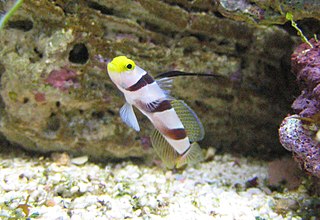
Stonogobiops nematodes, the Filament-finned prawn-goby, the Antenna goby, the high-fin goby, the red-banded goby, the high-fin red-banded goby, the striped goby, the barber-pole goby, or the black-ray Goby, is a species of marine goby native to the Indian Ocean and western Pacific Ocean from the Seychelles to the Philippines and Bali.
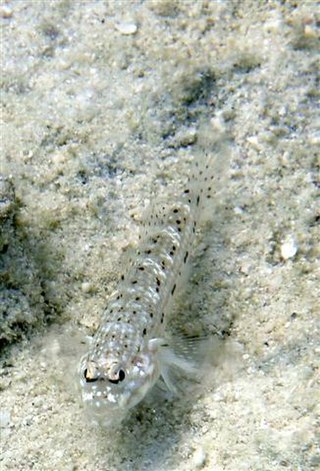
Fusigobius is a genus of coral reef inhabiting gobies found throughout the Indian and western Pacific Oceans.
Pascua is a genus of gobies native to the Pacific Ocean. The origin of the name "Pascua" is from the Spanish for "Easter" in recognition of the Easter Island range of the type specimen.

Amblyeleotris is a genus of fish in the family Gobiidae found throughout the Indo-Pacific region. This is the largest genus of the shrimp gobies or prawn gobies, so-called because of their symbiotic relationship with certain alpheid shrimps. The shrimp excavates and maintains a burrow used by both animals while the goby, which has far superior eyesight, acts as a lookout for predators. The shrimp maintains almost constant contact with the fish with an antenna. Fossil Amblyeleotris otoliths have been found together with alpheid shrimp remnants from as early as late early Miocene (Burdigalian) suggesting a possible mutualistic association since then.

Ctenogobiops is a genus of marine gobies native to the Indian and Pacific oceans.

Glossogobius is a genus of gobies native to fresh, brackish and marine waters from Africa to the coasts of the western Pacific Ocean. They are found in Madagascar, South Africa, Japan, Thailand, Australia, Indonesia, Bangladesh, the Philippines, Taiwan, Papua New Guinea, Singapore, Malawi, Eswatini, Botswana, Kenya, Zimbabwe, Tanzania, Mozambique, the Solomon Islands, Palau, Fiji, New Caledonia, India, Laos, Sri Lanka, Myanmar, Borneo, Nepal, Brunei Darussalam, Micronesia, Cambodia, Viet Nam, China, Réunion, the Seychelles, Mauritius, the Caroline Islands, Vanuatu, Malaysia and Russia. The genus also includes a troglobitic species, G. ankaranensis.
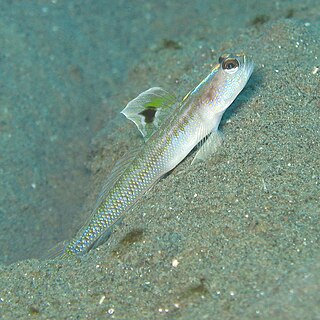
Vanderhorstia is a genus of gobies native to the Indian and Pacific oceans. The name of this genus honours the Dutch biologist Cornelius van der Horst (1889-1951) of the University of the Witwatersrand, Johannesburg, who was well known for his interest in marine biology.

Tomiyamichthys is a genus of gobies found from the Red Sea through the Indian Ocean to the western Pacific Ocean.

The yellow prawn-goby is a species of goby native to the Western Pacific, where it can be found at depths of from 1 to 25 metres in coastal bays and lagoons. This species is symbiotic with alpheid shrimps. The species can reach a length of 10 centimetres (3.9 in) SL. These fish vary greatly in appearance, ranging from brilliant yellow to gray and even brown forms or combinations of each coloring. This species is often kept in salt water aquariums. The yellow prawn-goby can be kept in aquariums as small as 20 gallons. In the marine hobby they are often partnered with tiger pistol shrimp.

Stonogobiops yasha, the Orange-striped shrimpgoby, is a species of goby native to the Western Pacific Ocean where it occurs at depths of from 15 to 40 metres. It inhabits sandy areas along the outer slopes of reefs where it lives in a commensal relationship with the shrimp Alpheus randalli. This species can reach a length of 4.7 centimetres (1.9 in) SL.

Alpheus randalli is a species of snapping shrimp in the family Alpheidae. It lives in the Marquesas Islands and parts of the Indian Ocean, including the Seychelles, in association with a goby of the genus Amblyeleotris. The shrimp is transparent or white with prominent red markings.
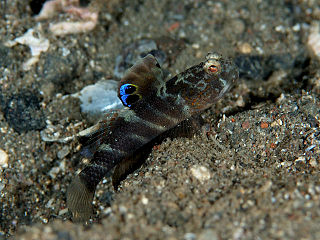
Mahidolia mystacina, the flagfin prawn goby, flagfin shrimpgoby or smiling goby, is a species of goby native to the Indian Ocean and the Pacific Ocean from Delagoa Bay, Mozambique to the Society Islands and from southern Japan to Samoa and northern Australia. This species occurs in marine and brackish waters, being found in coastal bays, estuaries and reef bases where the bottom is silty or muddy at depths of from 5 to 25 metres. This species is a commensal with a species of alpheid shrimp, using its burrow as its home. This species can reach a length of 8 centimetres (3.1 in) TL. This species can also be found in the aquarium trade. It is currently the only known member of its genus.

Cryptocentrus, also known as Watchman gobies, and one of the genera known as shrimp gobies or prawn gobies, is a genus of gobies native to tropical marine waters of the Indian and Pacific oceans.
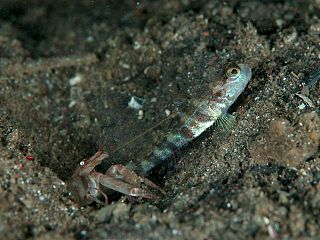
Myersina is a genus of ray-finned fish from the family Gobiidae, the true gobies which are found from the Atlantic coast of South Africa through the Indian Ocean to the western Pacific Ocean. The generic name honours the American ichthyologist George S. Myers (1905-1985) who was a younger colleague of Herre's at the time at which he described the genus and who went on to be president of the American Society of Ichthyologists and Herpetologists, the head of the Division of Fishes at the United States National Museum and an ichthyologist for the United States Fish and Wildlife Service.
Sueviota is a genus of fish in the family Gobiidae native to the Indian and Pacific Ocean.

Tryssogobius is a genus of small gobies native to the western Pacific Ocean. The species in this genus are known colloquially as "fairygobies".

Ptereleotris is a genus of dartfishes found in the Atlantic, Indian and Pacific oceans.
Helen K. Larson is an ichthyologist who specialises in the fishes of the Indo-Pacific.

















